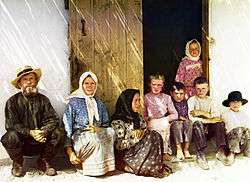Mugan plain

Mugan plain (Azeri: Muğan düzü, دشت مغان; Persian: دشت مغان, translit. Dasht-i Mūghān) is a plain in northwestern Iran and the southern part of the Republic of Azerbaijan. The highest density of irrigation canals is in the section of the Mugan plain which lies in the Republic of Azerbaijan. It is located on the bank of the Aras river extending to Iran. It contains highest density of irrigation canals is in the Mugan plain.[1]
Non-Orthodox Russian sects were not resettled here.
Alikemek-Tepesi
The ancient settlement of Alikemek-Tepesi (Alikemektepesi), dating to c. 5000 BC, is located in Mugan plain, and covers an area of over 1 hectare.[2] Early levels belonged to Shulaveri-Shomu culture.
Materials from this site are very close to the materials obtained from monuments of northwestern Iran (Dalma ware). The artifacts of the lower level are similar to those at Kültəpə I in Nakhchivan. In the upper levels, there is also pottery of the northern Ubaid period type.[3]
Some archaeologists speak of the ancient Alikemek-Kul'tepe culture of southeastern Caucasus, that followed the Shulaveri-Shomu culture, and covered the transition from the Neolithic to Chalcolithic periods (c. 4500 BC).
See also
Notes
- ↑ The Embassy of the Republic of Azerbaijan in Spain
- ↑ Махмудов Ф.Р., Нариманов П.Г., 1974. Поселение Аликемек-тепеси. АО 1973 г. М. (Russian)
- ↑ Proceedings of the International Conference „The Beginnings of Metallurgy", Bochum 1995